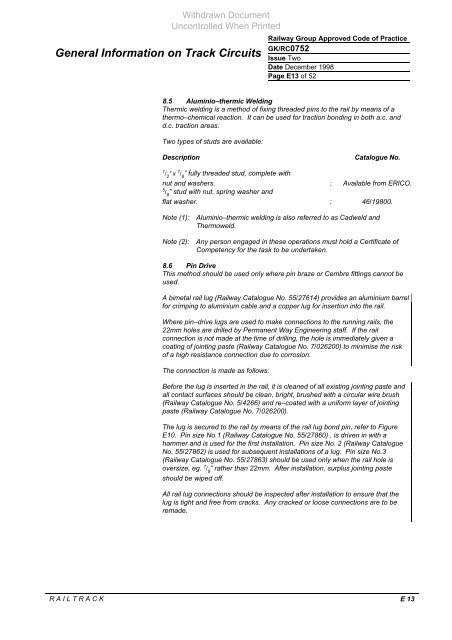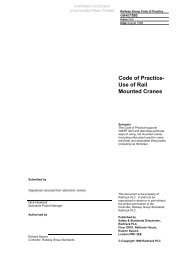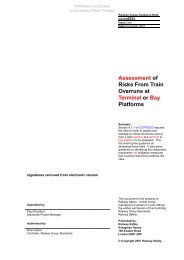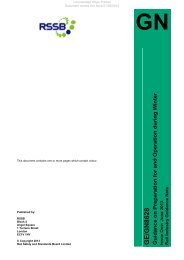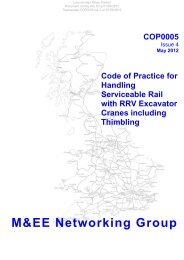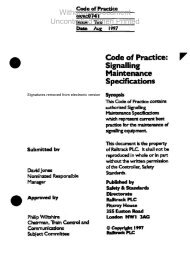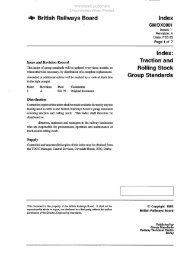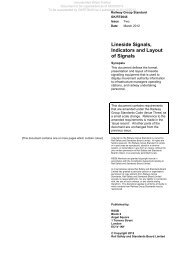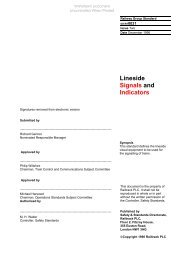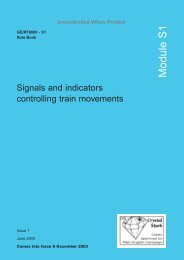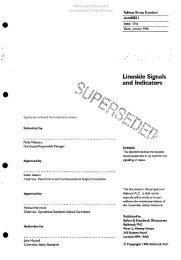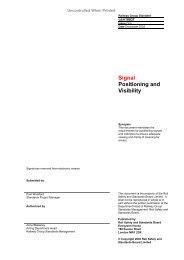General Information on Track Circuits - RGS Online
General Information on Track Circuits - RGS Online
General Information on Track Circuits - RGS Online
Create successful ePaper yourself
Turn your PDF publications into a flip-book with our unique Google optimized e-Paper software.
Withdrawn Document<br />
Unc<strong>on</strong>trolled When Printed<br />
<str<strong>on</strong>g>General</str<strong>on</strong>g> <str<strong>on</strong>g>Informati<strong>on</strong></str<strong>on</strong>g> <strong>on</strong> <strong>Track</strong> <strong>Circuits</strong><br />
Railway Group Approved Code of Practice<br />
GK/RC0752<br />
Issue Two<br />
Date December 1998<br />
Page E13 of 52<br />
8.5 Aluminio–thermic Welding<br />
Thermic welding is a method of fixing threaded pins to the rail by means of a<br />
thermo–chemical reacti<strong>on</strong>. It can be used for tracti<strong>on</strong> b<strong>on</strong>ding in both a.c. and<br />
d.c. tracti<strong>on</strong> areas.<br />
Two types of studs are available:<br />
Descripti<strong>on</strong> Catalogue No.<br />
1<br />
/2 ” x 7 / ” fully threaded stud, complete with<br />
8<br />
nut and washers.<br />
5<br />
/8 ” stud with nut, spring washer and<br />
: Available from ERICO.<br />
flat washer. : 46/19800.<br />
Note (1): Aluminio–thermic welding is also referred to as Cadweld and<br />
Thermoweld.<br />
Note (2): Any pers<strong>on</strong> engaged in these operati<strong>on</strong>s must hold a Certificate of<br />
Competency for the task to be undertaken.<br />
8.6 Pin Drive<br />
This method should be used <strong>on</strong>ly where pin braze or Cembre fittings cannot be<br />
used.<br />
A bimetal rail lug (Railway Catalogue No. 55/27614) provides an aluminium barrel<br />
for crimping to aluminium cable and a copper lug for inserti<strong>on</strong> into the rail.<br />
Where pin–drive lugs are used to make c<strong>on</strong>necti<strong>on</strong>s to the running rails, the<br />
22mm holes are drilled by Permanent Way Engineering staff. If the rail<br />
c<strong>on</strong>necti<strong>on</strong> is not made at the time of drilling, the hole is immediately given a<br />
coating of jointing paste (Railway Catalogue No. 7/026200) to minimise the risk<br />
of a high resistance c<strong>on</strong>necti<strong>on</strong> due to corrosi<strong>on</strong>.<br />
The c<strong>on</strong>necti<strong>on</strong> is made as follows:<br />
Before the lug is inserted in the rail, it is cleaned of all existing jointing paste and<br />
all c<strong>on</strong>tact surfaces should be clean, bright, brushed with a circular wire brush<br />
(Railway Catalogue No. 5/4266) and re–coated with a uniform layer of jointing<br />
paste (Railway Catalogue No. 7/026200).<br />
The lug is secured to the rail by means of the rail lug b<strong>on</strong>d pin, refer to Figure<br />
E10. Pin size No.1 (Railway Catalogue No. 55/27860) , is driven in with a<br />
hammer and is used for the first installati<strong>on</strong>. Pin size No. 2 (Railway Catalogue<br />
No. 55/27862) is used for subsequent installati<strong>on</strong>s of a lug. Pin size No.3<br />
(Railway Catalogue No. 55/27863) should be used <strong>on</strong>ly when the rail hole is<br />
oversize, eg. 7 / 8 ” rather than 22mm. After installati<strong>on</strong>, surplus jointing paste<br />
should be wiped off.<br />
All rail lug c<strong>on</strong>necti<strong>on</strong>s should be inspected after installati<strong>on</strong> to ensure that the<br />
lug is tight and free from cracks. Any cracked or loose c<strong>on</strong>necti<strong>on</strong>s are to be<br />
remade.<br />
R A I L T R A C K E 13


